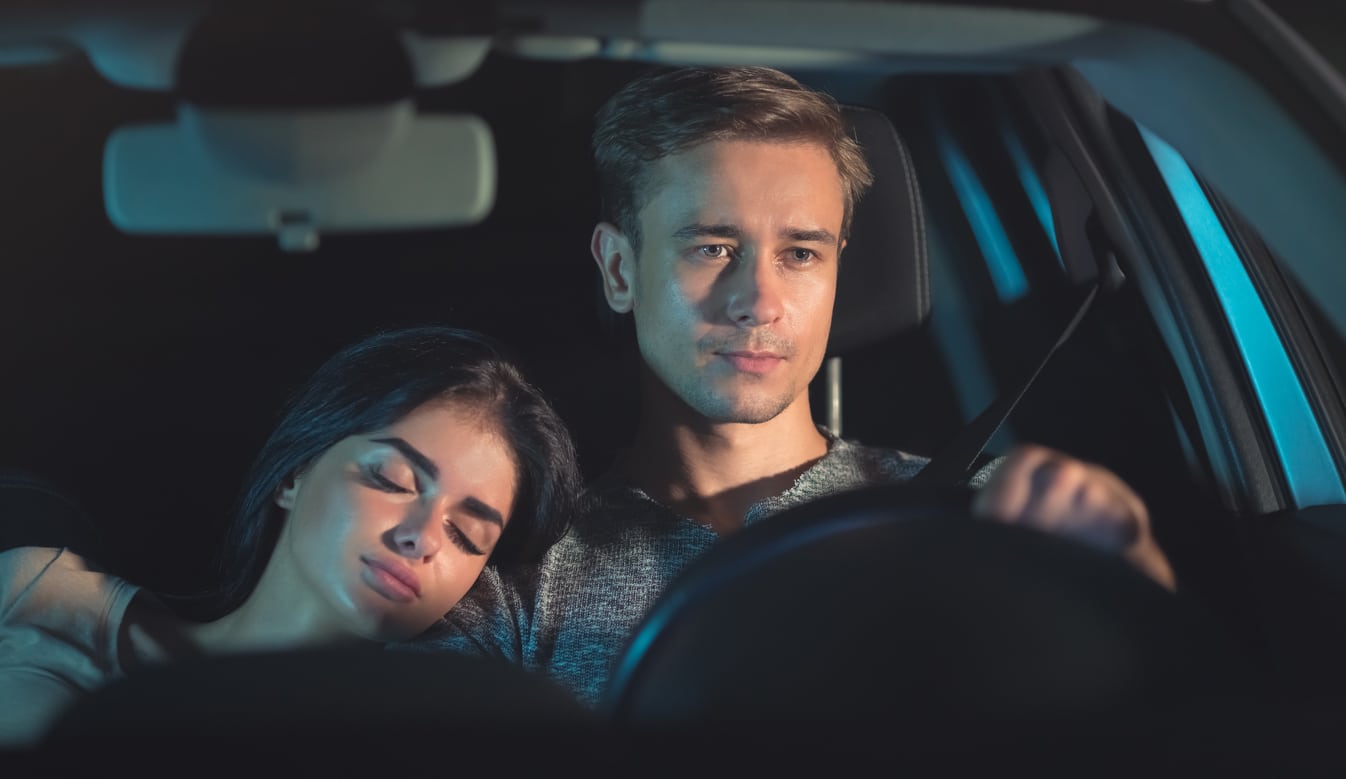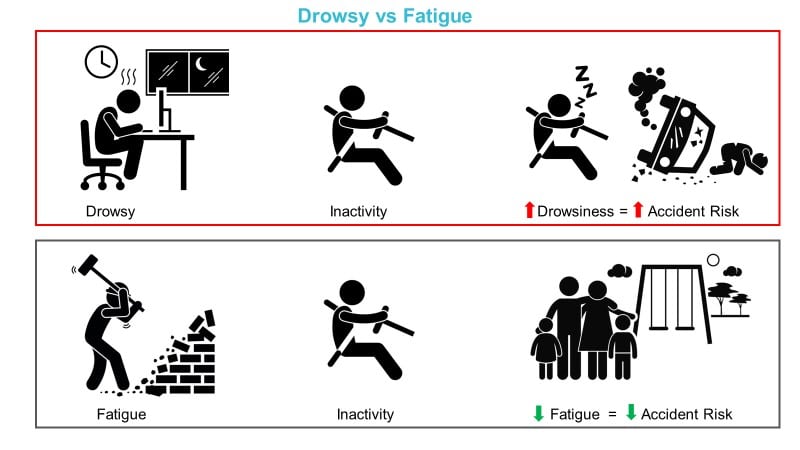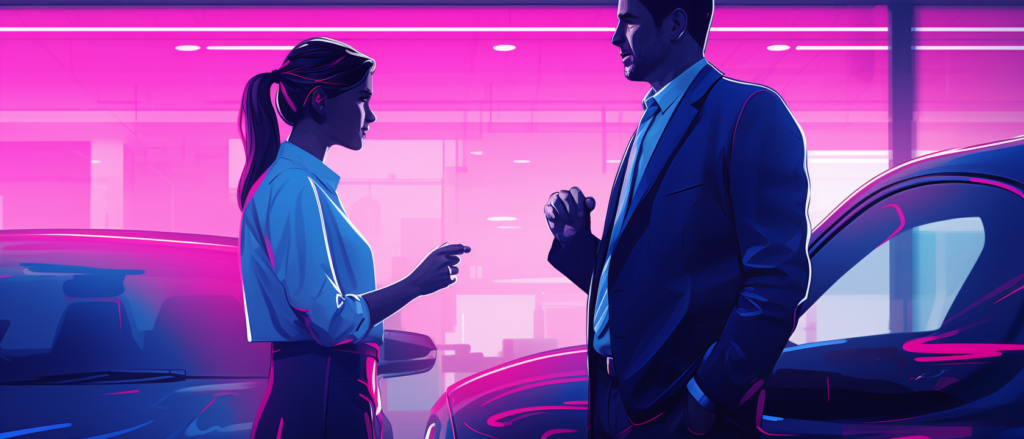
Sleep is essential for your brain function as well as your body.
Medical research shows sleep loss has detrimental effects on our health from weight gain to a weakened immune system. It can impact memory, increase risk of accidents, diabetes, the likelihood of cancers and has profound effects on the cardiovascular system1. Even a one-off sleep deprived situation, can cause drowsiness, cognitive impairment and increases the potential for a dangerous situation to occur.
Day light savings increases sleep deprivation, drowsiness and health risks
The man drive a car with a sleeping woman. evening night timeWith the introduction of daylight savings time (DST) in spring, and a loss of one hour of sleep, the risk of having a heart attack increases by 24% the following day. In autumn when we gain an hour of sleep, there’s a subsequent 21% decrease in heart attacks the next day3. The same profile appears with car and traffic accidents, whereby fatal car crashes increase by 6 percent the week following DST4. The change in time increases sleep deprivation, which often results in jet-lag symptoms. Feelings of drowsiness are particularly dangerous for people behind the wheel of a car and are equivalent to the risks of drunk driving.
Drowsiness vs Fatigue
The terms fatigue and drowsiness are often used interchangeably, however it is ‘drowsiness’ that is considered the more dangerous state. Drowsiness is the result of sleep impairment. It is a separate state in between sleep and wakefulness where we become cognitively impaired and are not as attentive as we would normally be.
We all pass through the drowsiness state on the way to sleep. It may not be a dangerous state if you are sitting watching television, but it certainly is a high risk if you’re driving a car. Our thinking and reaction times slow down, and these changes inevitably make us a higher risk when on the road.
Quite simply, as a driver’s sleep is decreased, they become drowsy and the ability to make fast decisions, assess danger and pay attention to the road is affected. Driving while drowsy represents a significant risk to fatal or serious car crashes and is attributed to approximately 20% of motor vehicle crashes5.
- Drowsiness however is increased by inactivity. Resting is likely to cause the individual to fall asleep.
Fatigue is quite a different state, it is defined by mental and/or physical exhaustion. Doing a task for many hours without a rest may cause you to feel fatigued, but not necessarily drowsy and fatigue gets progressively worse with the duration and intensity of the task. For example, we are fatigued after a long day working in the garden, or after a long duration of physical exercise.
- Physical fatigue is reduced by inactivity and resting normally would improve the individual’s fatigue and help to reinvigorate them.
Consequently, drowsiness can be much more dangerous than fatigue from a safety perspective. Feeling fatigued could be likened to feeling tired, exhausted or low in energy, but often does not result in sleep.

Fatigue (Drowsiness) Management System
Optalert technology detects the first signs of drowsiness and can be used to complement and enhance existing fatigue (drowsiness) management systems or occupational health and safety (OHS) policies. Prevention of drowsiness related accidents can be achieved through early warning.

Optalert’s technology is unique in that it detects drowsiness, from its earliest stages before the individual show’s signs of cognitive impairment. Optalert’s technology is a scientifically validated, early warning drowsiness detection system that objectively measures drowsiness using the patented Johns Drowsiness Scale (JDSTM). This scale can determine an individual’s alertness level and how likely they are to move to the dangerous state of drowsiness.
Older methods such as Perclos, detect long eye-lid closures, which is at the point of a micro-sleep. At this stage the individual has had their eyelids closed for too long, and it is often too late for that person to respond to a dangerous situation. Optalert’s eyelid movement technology is the next generation system which objectively measures drowsiness from the JDS scientific scale. The algorithm used has been developed and patented by Optalert and utilises a multitude of parameters to detect the earliest signs of drowsiness.
Optalert works with companies every day to help manage drowsiness issues which are especially risky for 24-hour operations. Whilst many strategies can be put in place to reduce the risks, drivers often aren’t aware of how at risk they really are. Drowsiness can strike even when you are not expecting it. That includes in the workplace, on the road and in other situations where your safety and the safety of others are in jeopardy. To find out more about Optalert’s drowsiness monitoring technology see: www.optalert.com
References:
- https://www.healthline.com/health/sleep-deprivation/effects-on-body#1
- https://www.timeanddate.com/time/dst/daylight-saving-health.html
- https://www.heart.org/en/news/2018/10/26/can-daylight-saving-time-hurt-the-heart-prepare-now-for-spring
- https://www.healthline.com/health-news/daylight-saving-can-make-driving-less-safe
- https://academic.oup.com/sleep/article/41/2/zsx195/4770267


